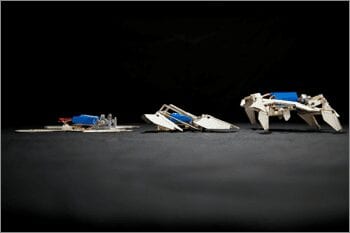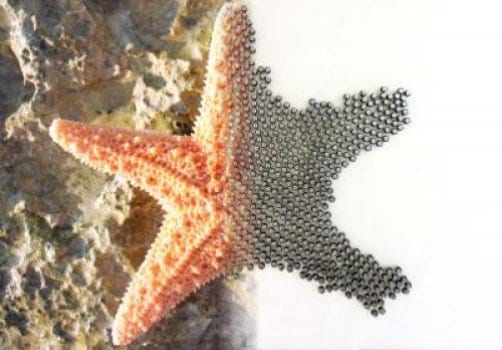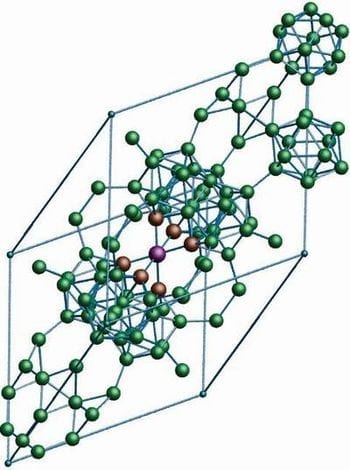
Credit: Harvard’s Wyss Institute
Demonstrates the potential for sophisticated machines that build themselves
A team of engineers used little more than paper and Shrinky dinks™ — the classic children’s toy that shrinks when heated — to build a robot that assembles itself into a complex shape in four minutes flat, and crawls away without any human intervention. The advance, described inScience, demonstrates the potential to quickly and cheaply build sophisticated machines that interact with the environment, and to automate much of the design and assembly process. The method draws inspiration from self-assembly in nature, such as the way linear sequences of amino acids fold into complex proteins with sophisticated functions.
“Getting a robot to assemble itself autonomously and actually perform a function has been a milestone we’ve been chasing for many years,” said senior author Rob Wood, Ph.D., a Core Faculty member at the Wyss Institute for Biologically Inspired Engineering at Harvard University and the Charles River Professor of Engineering and Applied Sciences at Harvard’s School of Engineering and Applied Sciences (SEAS). The team included engineers and computer scientists from the Wyss Institute, SEAS, and the Massachusetts Institute of Technology (MIT).
In addition to expanding the scope of ways one can manufacture robots in general, the advance harbors potential for rather exotic applications as well.
“Imagine a ream of dozens of robotic satellites sandwiched together so that they could be sent up to space and then assemble themselves remotely once they get there—they could take images, collect data, and more,” said lead author Sam Felton, who is pursuing his Ph.D. at SEAS.
The robots are the culmination of a series of advances made by the team over the last few years, including development of a printedrobotic inchworm — which still required human involvement while folding itself — and a self-folding lamp that had to be turned on by a person after it self-assembled.
The new robot is the first that builds itself and performs a function without human intervention.
Read more . . .
The Latest on: Self-assembling robot
[google_news title=”” keyword=”Self-assembling robot” num_posts=”10″ blurb_length=”0″ show_thumb=”left”]
via Google News
The Latest on: Self-assembling robot
- Simbe partners with Plexus to scale Tally inventory roboton May 9, 2024 at 6:52 am
Simbe Robotics, which said it recorded a 3x increase in its subscription revenue in 2023, is scaling production of its Tally inventory robot.
- We got our hands on Dyson’s new robot vacuum, the 360 Vis Nav. Here’s our reviewon May 8, 2024 at 10:31 am
Its suction power and edge cleaning capabilities are impressive, but it lacks features like mopping and self-emptying that we'd expect ... the back of the docking base and shove the robot into its ...
- Magnetic microrobot swarms clean water of microplastics and bacteriaon May 8, 2024 at 6:02 am
Microplastics are one of the biggest environmental and health risks faced by our generation. Now, researchers have developed swarms of tiny robots, or microrobots, that not only microplastics from ...
- These astonishing biobots can help neurons regrow — but researchers have no idea howon May 7, 2024 at 12:57 am
Scientists have created tiny, self-assembling robots made from human cells that could one day repair damaged skin and tissue. These tiny biological machines, called Anthrobots, are made from human ...
- Commentary: How robots making your burger and fries can lead to greater income inequalityon May 6, 2024 at 1:00 am
On April 1, more than half a million fast-food workers in California got a raise, with minimum wage across the sector bumped up to $20 per hour. That same week, ...
- Robotics, Sustainability, Resiliency Are Standards For Future Homeson May 3, 2024 at 6:01 am
Three startups demonstrate that technology and automation can be used to produce homes faster, at lower costs and with better performance.
- This Eufy self-emptying robot vacuum is over 50% offon May 2, 2024 at 5:00 pm
With 2,000Pa suction power, Wi-Fi connectivity, planned pathfinding, and the ability to self-empty, the Eufy 30+ offers features of a $400+ robot vacuum, but it's currently on sale for $197.
- A Roundup of New Robotson May 1, 2024 at 6:16 am
The cups are available in four diameters, from 40 to 100 millimeters, and three mounting configurations (3/8G male or female and 32 millimeter square). All are made from thermoplastic polyurethane for ...
- Best Robot Vacuums for 2024on April 26, 2024 at 7:15 am
We've picked out the best robot vacuums after putting them through extensive testing methodologies we've fine-tuned over the years. Originally hailing from Troy, Ohio, Ry Crist is a writer ...
- Will Robots Replace Warehouse Workers?on April 25, 2024 at 6:27 am
Robots are transforming the warehouse & manufacturing industry. From efficient order fulfilment to job security, learn what roles are safe amidst automation.
via Bing News











